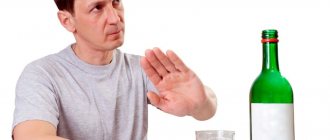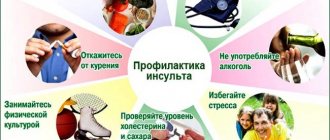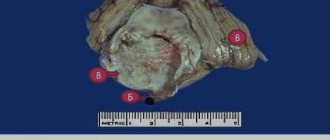- How stroke is related to age and gender
- Controllable risk factors
- What blood pressure can lead to stroke
- Monitoring heart function
- Maintaining normal sugar levels
- Controlling cholesterol levels
- Rejection of bad habits
- Maintaining a Healthy Body Weight
Stroke is otherwise called acute cerebral insufficiency or cerebrovascular accident (CVA).
Depending on the type of disease, ischemic and hemorrhagic stroke are distinguished. In the first case, the cause of the pathology is a blood clot that has blocked the vessel. In the second, there is damage to the vascular wall, which causes bleeding in the brain. In developed countries, strokes are the second leading cause of death. The difficulty for the patient and his relatives is rehabilitation, which takes a long time and requires considerable physical and moral strength.
That is why you need to think about how to prevent a brain stroke and maintain your health. What factors can lead to vascular accident, and how can they be controlled?
How stroke is related to age and gender
Doctors divide risk factors for stroke into controllable and uncontrollable. Among the uncontrollable are gender, age, heredity.
Previously, acute cerebrovascular accident was diagnosed in elderly people over 60 years of age. Due to physiological changes in the body, the risk of vascular pathology in adulthood increases.
Until recently, the proportion of young and middle-aged stroke patients was extremely small. Now, according to statistics, a third of acute stroke cases occur in people aged 20 to 60 years. Rejuvenation of strokes is a trend that doctors associate with the acceleration of the pace of life of the modern generation. This increases the amount of stress and contributes to psycho-emotional overload, which, combined with a lack of physical activity, negatively affects health.
In young and middle age, men are more susceptible to strokes than women, and after 50 years, gender loses its significance. Among elderly patients who have suffered a crisis, the number of men and women is approximately equal. Doctors associate the tendency of the young male population to strokes with bad habits, stress, and neglectful attitude towards their health.
Heredity is another factor that cannot be controlled, but must be taken into account. If your close relatives have cardiovascular diseases, it is recommended to pay more attention to your own health and undergo regular preventive examinations.
Types of stroke
Clinically, secondary and primary stroke are distinguished. There are also pathologies that are subarachnoid, hemorrhagic, and ischemic in nature. Ischemic pathology often occurs during a heart attack and is characterized by acute disruption of the conductivity of cerebral vessels, the formation of blood clots and air plugs.
With the hemorrhagic variant of the disease, local, extensive and generalized foci of hemorrhage appear. Sometimes the entire brain zone is affected, which is characterized by a malignant course. Subarachnoid stroke occurs due to traumatic rupture of blood vessels and often causes irreversible tissue damage.
What blood pressure can lead to stroke
Hypertension is the very first cause of vascular accidents. With blood pressure above 160/90, the risk of stroke increases fourfold. If blood pressure reaches 200/110 or higher, the likelihood of a stroke increases 10 times. You can control your blood pressure at home using a tonometer. Don't neglect this simple safety measure. Even if you feel well, you may find that your blood pressure is elevated. It is necessary to understand that high blood pressure can be not only an independent disease, but also a symptom of pathology of other organs and systems. This form of hypertension is called secondary. It often affects people with diabetes, kidney disease, and endocrine disorders.
In addition, there is so-called essential (primary) hypertension. Its difference from secondary hypertension is that there are no disorders in the body that could cause an increase in pressure. To identify the exact cause of high blood pressure, you should consult a doctor.
Treatment of any form of hypertension begins with optimizing nutrition and normalizing the daily routine. In order for blood pressure to remain normal, it is necessary to avoid excessive consumption of salt, caffeine, and alcohol. You should avoid physical and emotional overload and devote enough time to rest.
Chronically high blood pressure is treated with medication. The doctor selects a combination of drugs and their dosage.
Types of disease prevention
How to avoid a stroke? There are several methods that are graded depending on the nature of the disease. In any case, this is a complex process that includes proper patient care, the use of the basics of exercise therapy, therapeutic massage and therapeutic drugs. There may be a lot of reasons, but the methods of influencing the body should prevent undesirable consequences.
In clinical medicine, the following types of preventive effects are distinguished:
- Primary. It allows you to avoid the onset of the disease before its clinical signs;
- Secondary. A set of therapeutic and physiotherapeutic measures that prevent repeated damage to brain tissue, which can threaten the death of the patient;
- Tertiary. It is developed against the background of secondary measures, when there is already a history of stroke. This is medicinal, psychological, labor rehabilitation, which allows you to return a person to a normal life.
Controlled and uncontrollable risk factors should also be taken into account and differentiated. How to prevent a stroke? It is necessary to exclude uncontrolled hypertension, trying to keep blood pressure normal, stop drinking alcohol and smoking tobacco, and be aware of the presence of embologenic cardiac pathologies, which are detected by ultrasound or ECG of the heart.
We have identified controllable risk factors. Uncontrollable factors include physiological age. It is no secret that after 55 years, the likelihood of a stroke increases by more than two and a half times. This also includes being male and genetic background.
Maintaining normal sugar levels
Glucose is necessary for organs and tissues, but its excess content in the blood is fraught with negative consequences for the health of the vascular system. Studies have shown that with diabetes, the risk of stroke increases three to five times, and the disease is characterized by a more acute course and a larger scale of damage. Elevated blood glucose levels have a bad effect on the health of small vessels, leading to poor circulation and damage to the vascular walls. This condition is called diabetic angiopathy.
Diabetics are also susceptible to early development of atherosclerosis: with diabetes, its symptoms are diagnosed 10-12 years earlier than in people without diabetes. Atherosclerosis affects the carotid and vertebral arteries, leading to narrowing of the lumen of blood vessels and impaired blood flow.
To prevent strokes, it is important to regularly monitor glucose levels and avoid overusing foods with large amounts of fast carbohydrates and fat. If a patient is diagnosed with diabetes, it is necessary to adhere to the doctor's recommendations for taking medications and nutrition. Modern medications allow you to keep sugar under control and thereby avoid the negative effects of hyperglycemia on health.
Medicines and drugs to prevent stroke
Medicines used to prevent stroke can be divided into the following groups:
- antihypertensive drugs (enalapril, lisinopril, etc.). People with hypertension have a greater risk of developing stroke. Drugs in this group, their dosage and methods of administration are prescribed by a doctor;
- antiplatelet agents (thromboass, cardiomagnyl, aspirin). These drugs help prevent blockage of blood vessels and the formation of blood clots. They are also prescribed by a doctor, but, as a rule, they are taken according to the scheme one month on - a month off;
- diuretics (Lasix, furosemide, etc.) are medications that remove excess sodium from the body and relieve swelling.
Under no circumstances should you take medications on your own. The choice of drug, the schedule for its administration and dosage should be prescribed exclusively by a qualified specialist, since a lot depends on the individual characteristics of the body and the current clinical picture. Otherwise, you may not only not help the body avoid a stroke, but also cause significant harm to it.
Controlling cholesterol levels
Excess cholesterol leads to atherosclerosis, which affects the blood vessels of the brain. In their lumen, atheromatous (atherosclerotic) plaques form, due to which blood cannot circulate normally. In severe cases, this leads to blockage of the vessel by a blood clot or rupture, that is, hemorrhage in the brain. The development of atherosclerosis is promoted by smoking, alcohol abuse, and a diet with a predominance of foods containing large amounts of animal fat and trans fats. With diabetes mellitus, excess body weight, immobility, hormonal pathologies, which are accompanied by lipid metabolism disorders, the risk of developing the disease increases many times over.
Atherosclerosis in many cases does not manifest itself externally. Negative symptoms occur when an atherosclerotic plaque has more than half blocked the lumen of the vessel. If the vessels of the brain are affected, this is manifested by emotional lability, deterioration of sleep, decreased memory and attention.
The disease in its early stages can only be determined through medical research. People over 40 years of age, including patients without heart or other pathologies, should be tested for total cholesterol and low-density lipoproteins (LDL) for preventive purposes. We are talking about a lipidogram - a special biochemical blood test. Total cholesterol levels should not exceed 5.7 mmol/l, and LDL levels should be within 1.8 mmol/l.
If there are signs of vascular damage, the doctor additionally prescribes hardware diagnostics: X-ray examination, ultrasound.
Conservative treatment of atherosclerosis involves taking medications to lower cholesterol and prevent blood clots, as well as changing your diet. In severe cases, when a serious blood flow disorder is established, the patient is recommended to undergo surgery.
What can be done before the doctors arrive? The main thing is don’t panic!
- remove everything that gets in the way: remove dentures, lenses, glasses, unbutton your collar, loosen your tie, raise your head 20-30 cm, open the window
- unconscious person? Open his mouth, tilt his head slightly to the side
- was there vomiting? Clean your mouth from vomit with a clean handkerchief.
- are there any cramps? Remove objects that could cause injury or bumps.
- no pulse or breathing? Start artificial respiration and chest compressions. It's worth learning this in advance.
- If you can obtain such information, write down the names and dosages of medications that the victim is taking.
Rejection of bad habits
Alcohol abuse and smoking increase the risk of stroke by three to four times. Smokers have increased stress on the walls of blood vessels, which is caused by exposure to nicotine. Tobacco users are more likely to suffer from hypertension, heart failure and other pathologies that increase the risk of stroke.
Alcoholic drinks destroy the walls of blood vessels. They become more brittle. Drinkers have an increased risk of hemorrhagic stroke, which involves bleeding in the brain. Alcohol abuse also negatively affects the state of platelets. This can lead to the formation of blood clots and blockage of blood vessels in the brain. Tissues stop receiving oxygen, which leads to their death.
Scientists have found that daily consumption of three or more glasses of drinks with a high content of ethyl alcohol contributes to the development of stroke at a younger age. For people who drink, their first stroke most often occurs between the ages of 50 and 60. This is due to premature degenerative changes in vascular tissues caused by exposure to alcohol. In patients without alcohol dependence, vascular accidents mostly occur at the age of 70-75 years.
Like smokers, drinkers often suffer from hypertension, which is the biggest risk factor for stroke.
Giving up bad habits will significantly reduce the load on the cardiovascular system and increase the effectiveness of treatment.
How to prevent a stroke - 12 tips
Contents:
What is a stroke in medical terminology Who is at risk for this disease The first symptoms of a stroke What are the ways to prevent strokes 12 tips that will help you avoid a stroke What medications will help prevent a stroke Traditional medicine How to avoid a recurrent stroke
According to statistics, stroke is a disease that causes the death of six and a half million people every year. Are there any chances to avoid this dangerous disease? What methods are there to prevent stroke? How effective are they? We will try to tell you about all this in this article.
What is a stroke in medical terminology
A stroke is an acute sudden disturbance of blood circulation in the vessels of the brain with damage to their integrity and the release of blood from the bloodstream into the membranes of the brain and medulla. In medicine, there are two classifications of strokes:
- Ischemic;
- Hemorrhagic.
Ischemic develops as a result of a malnutrition of a part of the brain caused by vascular spasm or thrombosis. Hemorrhagic stroke is characterized by the rupture of blood vessels and the release of blood from them. It is one of the 5 most serious diseases in the world and the mortality rate as a result of this disorder is almost 100%.
Ischemic stroke is diagnosed several times more often than hemorrhagic stroke, but the mortality rates are not nearly as high. This is explained by the fact that with timely medical intervention, arterial spasm is relieved, a thrombus or embolus is removed, and blood circulation is resumed.
Stroke falls into the category of seasonal diseases. Most often, strokes occur in the spring months. In Russia, doctors record approximately 400 thousand cases per year.
Patients who have suffered a stroke experience some irreversible symptoms - frequent headaches, severe speech impairment, paralysis.
Hemorrhagic stroke occurs as a result of constant physical exertion or prolonged exposure to stress. The main predisposing factors are certain diseases - hypertension or arterial sclerosis. In the summer months, people often cannot withstand the stress of their summer cottages and a stroke overtakes them right in the garden.
Who is at risk for this disease?
Doctors have identified groups of the population whose risk of stroke is significantly higher than others. These include:
- People suffering from diabetes;
- Hypertensive patients;
- Patients with high levels of total blood cholesterol;
- Men over 45 years of age;
- Women over 65 years of age.
The first symptoms of a stroke
The first symptoms of the disease can be noticed 24 hours before the onset of the acute period. The patient complains of:
- Severe, persistent headaches;
- Sudden loss of clarity of consciousness;
- General depression.
The cause of these symptoms is a disruption in the movement of blood through the vessels.
An ischemic stroke develops in 4-6 hours, in rare cases the process takes 2-3 days. Symptoms appear at night or early in the morning. The patient's face is pale, sometimes with a bluish tint. The sensitivity of the skin, fingertips and toes is sharply reduced. Speech, olfactory and visual functions are impaired. Often a person does not recognize relatives and friends, and cannot correctly name the object. The hemipara develops on the opposite side of the body relative to the damaged area of the brain.
Hemorrhagic stroke occurs suddenly and does not show any early symptoms. An attack occurs during severe physical or psycho-emotional stress, in most cases during the day. The main symptoms of hemorrhagic stroke are:
- Sudden changes in body temperature;
- Facial hyperemia;
- Sticky sweat;
- Breathing disorders;
- Sudden increase in blood pressure.
The attack ends in deep fainting.
What are the ways to prevent strokes?
A large percentage of patients who have suffered a stroke become disabled, partially or completely losing their legal capacity. In order to avoid stroke, people, especially those who are at risk, as well as their relatives, need to carefully monitor their condition so as not to miss the first signs of the disease.
If a person complains of headaches, increased fatigue, or a temporary disorder of the speech apparatus occurs, he should immediately consult a doctor. A visit to a specialist is necessary even if symptoms appear rarely and for a short period of time.
The first thing you need to adjust is your diet. It is necessary to reduce the amount of fatty, spicy, smoked, salty foods. It is recommended to reduce the daily amount of salt. Be sure to consume at least 400 grams of vegetables and fruits daily.
Eating foods of plant origin reduces the risk of ischemia by 5-7%. Particular attention should be paid to fruits and berries containing vitamin C.
Vegetable meal options:
- One large green apple, banana, orange or half a grapefruit;
- 150-200 grams of fresh berries;
- A glass of freshly squeezed fruit juice;
- 2 tablespoons of dried fruits, pre-soaked in warm water;
- Any vegetable;
- Green salad.
Eating one green Granny Smith apple daily can significantly reduce the risk of stroke. This effect of the fruit is due to the presence of phenolic acid, which is a strong antioxidant. It increases the elasticity of the walls of blood vessels and prevents the formation of blood clots.
12 tips to help you avoid a stroke
- Monitor your blood pressure level - you need to independently measure your blood pressure with a tonometer several times a day. For convenience and speed, it is better to use an electronic automatic device. It is best if you keep a diary in which you note the time of measurement, numbers and factors that could affect the pressure surge.
- Do not forget about the prevention of diabetes mellitus - this is the disease that dramatically increases the chances of a stroke. Monitor your diet, measure your blood glucose levels and try not to forget about physical activity.
- Avoid foods with high levels of cholesterol - this is what forms cholesterol plaques, which lead to narrowing of the lumens of blood vessels. Include vegetables, fruits, legumes, oatmeal, olive oil, and low-fat fish in your diet.
- Control your weight - prevent the development of obesity and carefully monitor your body mass index. Even 3-5 kg of excess weight can increase the risk of stroke.
- Carefully monitor your menu and the products in it - bananas, sweet potatoes, dried fruits contain a large amount of potassium. They have a beneficial effect on all muscles and blood vessels in the human body. Prepare green and vegetable salads more often and season them with olive oil.
- Avoid alcohol - it has an extremely negative effect on blood pressure levels, dilating and then constricting blood vessels, which leads to strong fluctuations in blood pressure. The exception is 30 ml of dry red wine.
- Don't smoke - smoking is one of the three main causes of stroke. Tobacco smoke and nicotine cause constant spasm of all blood vessels, including the brain.
- Take care of your sleep schedule - a person needs at least 7 hours of sound, uninterrupted sleep per day.
- Do not use hormonal drugs - this rule applies, in most cases, to females. It is hormonal contraceptives that increase the risk of blood clots by 30-40%.
- Monitor your mood and prevent depression - prolonged deep depression increases the risk of cerebral hemorrhage by 15-20%. If you cannot get out of this state on your own, it is recommended to contact a competent specialist for supportive therapy.
- Monitor your heart rate - People with a history of atrial fibrillation are at risk for stroke. Moderate atrial fibrillation promotes the formation of blood clots in the chambers of the heart. The risk of stroke in a person suffering from “flicker” increases 5 times!
- If you feel symptoms that are precursors to a stroke, immediately consult a doctor - he will conduct an examination, prescribe additional tests and make a final diagnosis. After this, the specialist will select drug therapy that will reduce the risk of stroke.
What medications can help prevent stroke?
All medications are divided into categories:
- Antihypertensive drugs that lower blood pressure. These include enalapril, lisinopril and others;
- Antiplatelet agents are blood thinners that reduce the risk of blood clots by preventing particles from sticking together. These drugs include Aspirin, Thrombo-Ass and Cardiomagnyl.
- Diuretics are diuretic drugs. They remove excess fluid from the body and reduce pressure on the walls of blood vessels. This group of drugs includes Furosemide, Veroshpiron, Lasix.
All these medications must be prescribed by a doctor, who also regulates the dosage and frequency of administration. Self-administration of medications can worsen the situation!
Traditional medicine
Traditional medicine is often used in the prevention of strokes:
- Aloe leaves - before collecting the material, the plant is not watered for 3-5 days. 350 grams of pre-crushed aloe leaves, 600 grams of honey, 650 ml of dry red wine are combined in a container. Infuse for 5-7 days in a place protected from light;
- Elecampane root - 30 grams of root are infused in 1000 ml of vodka, infuse for 35-40 days;
- Stinging nettle leaves - crushed leaves weighing 200 grams are infused in 500 ml of vodka;
- Mustard powder – used for making mustard plasters and mustard foot baths.
How to avoid another stroke
Often people who have had one stroke suffer a second one after some time. The following factors can trigger a relapse:
- Smoking;
- Drinking strong alcoholic drinks;
- Drug use;
- Failure to comply with the work and rest schedule;
- Ignoring healthy lifestyle;
- Incorrectly composed diet;
- Blood pressure surges;
- Frequent and severe stress.
Basic rules for preventing recurrent stroke:
- It is necessary to follow the medication regimen prescribed by the attending physician;
- Undergo preventive examinations;
- Stick to a balanced diet;
- Lead a healthy lifestyle;
- Remember to exercise regularly;
- Monitor your blood pressure levels;
- Keep a first aid kit with emergency first aid supplies on hand.
Stroke is an insidious and terrible disease, the consequences of which often lead to partial or complete loss of body functions. Stroke patients often require constant care. Relatives are not always able to provide it due to certain circumstances. In this case, it is recommended to consider the option of temporary or permanent stay in a specialized boarding house.
Maintaining a Healthy Body Weight
Excessive accumulation of fat deposits, especially in the abdominal area, increases the risk of stroke. People who are overweight are more likely to have type 2 diabetes and other diseases that cause complications on the heart and blood vessels. Also, people of heavy build are more likely to suffer from high blood pressure. All these factors together create a risk of stroke.
To maintain a healthy weight, you need to monitor your diet, control your hormonal levels, and ensure adequate physical activity. The most beneficial for blood vessels are aerobic exercises. These are walking, race walking, cycling, swimming.
Women taking hormonal contraceptives should be especially attentive to their health. Such drugs increase appetite, and if the dosage is incorrectly selected, the risk of vascular damage increases.
Atypical stroke: be careful!
Sometimes a stroke is “masked.” There may be no typical signs. However, if:
- sudden and severe pain in an arm or leg
- nausea or vomiting appeared, severe stomach pain
- severe weakness appeared
- there were chest pains, palpitations, interruptions in heart function
- unexplained insomnia appeared - these symptoms also occur with a stroke, especially in women. Don't delay your visit. Even young and apparently healthy people can have a stroke.









